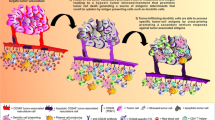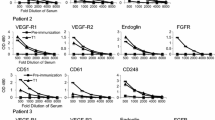Abstract
A functional vasculature is essential for tumor progression and malignant cell metastasis. Endothelial cells lining blood vessels in the tumor are exposed to a unique microenvironment, which in turn induces expression of specific proteins designated as tumor endothelial markers (TEMs). TEMs either localized at the plasma membrane or secreted into the extracellular matrix are accessible for antibody targeting, which can be either infused or generated de novo via vaccination.
Recent studies have demonstrated vaccines against several TEMs can induce a strong antibody response accompanied by a potent antitumor effect in animal models. These findings present an exciting field for novel anticancer therapy development. As most of the TEMs are self-antigens, breaking tolerance is necessary for a successful vaccine. This chapter describes approaches to efficiently induce a robust antibody response against the tumor vasculature.
Access this chapter
Tax calculation will be finalised at checkout
Purchases are for personal use only
Similar content being viewed by others
References
Dachs GU, Chaplin DJ (1998) Microenvironmental control of gene expression: implications for tumor angiogenesis, progression, and metastasis. Semin Radiat Oncol 8:208–216
Zhuang X, Cross D, Heath VL, Bicknell R (2011) Shear stress, tip cells and regulators of endothelial migration. Biochem Soc Trans 39:1571–1575
Matejuk A, Leng Q, Chou ST, Mixson AJ (2011) Vaccines targeting the neovasculature of tumors. Vasc Cell 3:7
Los M, Roodhart JM, Voest EE (2007) Target practice: lessons from phase III trials with bevacizumab and vatalanib in the treatment of advanced colorectal cancer. Oncologist 12:443–450
Ridolfi L, Petrini M, Fiammenghi L, Riccobon A, Ridolfi R (2009) Human embryo immune escape mechanisms rediscovered by the tumor. Immunobiology 214:61–76
Haller BK, Brave A, Wallgard E et al (2010) Therapeutic efficacy of a DNA vaccine targeting the endothelial tip cell antigen delta-like ligand 4 in mammary carcinoma. Oncogene 29:4276–4286
Huijbers EJ, Ringvall M, Femel J et al (2010) Vaccination against the extra domain-B of fibronectin as a novel tumor therapy. FASEB J 24:4535–4544
Jarosz M, Jazowiecka-Rakus J, Cichon T et al (2013) Therapeutic antitumor potential of endoglin-based DNA vaccine combined with immunomodulatory agents. Gene Ther 20:262–273
Yoshikawa M, Mukai Y, Okada Y et al (2013) Robo4 is an effective tumor endothelial marker for antibody-drug conjugates based on the rapid isolation of the anti-Robo4 cell-internalizing antibody. Blood 121:2804–2813
Mura M, Swain RK, Zhuang X et al (2012) Identification and angiogenic role of the novel tumor endothelial marker CLEC14A. Oncogene 31:293–305
Grone J, Doebler O, Loddenkemper C, Hotz B, Buhr HJ, Bhargava S (2006) Robo1/Robo4: differential expression of angiogenic markers in colorectal cancer. Oncol Rep 15:1437–1443
Huminiecki L, Gorn M, Suchting S, Poulsom R, Bicknell R (2002) Magic roundabout is a new member of the roundabout receptor family that is endothelial specific and expressed at sites of active angiogenesis. Genomics 79:547–552
Seth P, Lin Y, Hanai J, Shivalingappa V, Duyao MP, Sukhatme VP (2005) Magic roundabout, a tumor endothelial marker: expression and signaling. Biochem Biophys Res Commun 332:533–541
Marlow R, Binnewies M, Sorensen LK et al (2010) Vascular Robo4 restricts proangiogenic VEGF signaling in breast. Proc Natl Acad Sci U S A 107:10520–10525
Zhuang X, Ahmed F, Zhang Y et al (2015) Robo4 vaccines induce antibodies that retard tumor growth. Angiogenesis 18:83–95
Opie EL, Freund J (1937) An experimental study of protective inoculation with heat killed Tubercle bacilli. J Exp Med 66:761–788
Davenport FM (1968) Seventeen years’ experience with mineral oil adjuvant influenza virus vaccines. Ann Allergy 26:288–292
Toellner KM, Luther SA, Sze DM et al (1998) T helper 1 (Th1) and Th2 characteristics start to develop during T cell priming and are associated with an immediate ability to induce immunoglobulin class switching. J Exp Med 187:1193–1204
Dwyer MA, Huang AJ, Pan CQ, Lazarus RA (1999) Expression and characterization of a DNase I-Fc fusion enzyme. J Biol Chem 274:9738–9743
Garside P, Ingulli E, Merica RR, Johnson JG, Noelle RJ, Jenkins MK (1998) Visualization of specific B and T lymphocyte interactions in the lymph node. Science 281:96–99
Femel J, Huijbers EJ, Saupe F et al (2014) Therapeutic vaccination against fibronectin ED-A attenuates progression of metastatic breast cancer. Oncotarget 5:12418–12427
Huijbers EJ, Femel J, Andersson K, Bjorkelund H, Hellman L, Olsson AK (2012) The non-toxic and biodegradable adjuvant Montanide ISA 720/CpG can replace Freund’s in a cancer vaccine targeting ED-B—a prerequisite for clinical development. Vaccine 30:225–230
Francia G, Kerbel RS (2010) Raising the bar for cancer therapy models. Nat Biotechnol 28:561–562
Attia MA, Weiss DW (1966) Immunology of spontaneous mammary carcinomas in mice. V. Acquired tumor resistance and enhancement in strain A mice infected with mammary tumor virus. Cancer Res 26:1787–1800
Crnic I, Christofori G (2004) Novel technologies and recent advances in metastasis research. Int J Dev Biol 48:573–581
Miller FR, Miller BE, Heppner GH (1983) Characterization of metastatic heterogeneity among subpopulations of a single mouse mammary tumor: heterogeneity in phenotypic stability. Invasion Metastasis 3:22–31
Aslakson CJ, Miller FR (1992) Selective events in the metastatic process defined by analysis of the sequential dissemination of subpopulations of a mouse mammary tumor. Cancer Res 52:1399–1405
Pulaski BA, Ostrand-Rosenberg S (1998) Reduction of established spontaneous mammary carcinoma metastases following immunotherapy with major histocompatibility complex class II and B7.1 cell-based tumor vaccines. Cancer Res 58:1486–1493
Tao K, Fang M, Alroy J, Sahagian GG (2008) Imagable 4T1 model for the study of late stage breast cancer. BMC Cancer 8:228
Huang X, Wong MK, Yi H et al (2002) Combined therapy of local and metastatic 4T1 breast tumor in mice using SU6668, an inhibitor of angiogenic receptor tyrosine kinases, and the immunostimulator B7.2-IgG fusion protein. Cancer Res 62:5727–5735
Hanahan D (1985) Heritable formation of pancreatic beta-cell tumours in transgenic mice expressing recombinant insulin/simian virus 40 oncogenes. Nature 315:115–122
Zanivan S, Maione F, Hein MY et al (2013) SILAC-based proteomics of human primary endothelial cell morphogenesis unveils tumor angiogenic markers. Mol Cell Proteomics 12:3599–3611
Acknowledgements
We thank Kai-Michael Toellner for the advice and help regarding the alum-based vaccination protocol.
Author information
Authors and Affiliations
Corresponding author
Editor information
Editors and Affiliations
Rights and permissions
Copyright information
© 2016 Springer Science+Business Media New York
About this protocol
Cite this protocol
Zhuang, X., Bicknell, R. (2016). Development of Antibody-Based Vaccines Targeting the Tumor Vasculature. In: Thomas, S. (eds) Vaccine Design. Methods in Molecular Biology, vol 1403. Humana Press, New York, NY. https://doi.org/10.1007/978-1-4939-3387-7_48
Download citation
DOI: https://doi.org/10.1007/978-1-4939-3387-7_48
Published:
Publisher Name: Humana Press, New York, NY
Print ISBN: 978-1-4939-3385-3
Online ISBN: 978-1-4939-3387-7
eBook Packages: Springer Protocols




